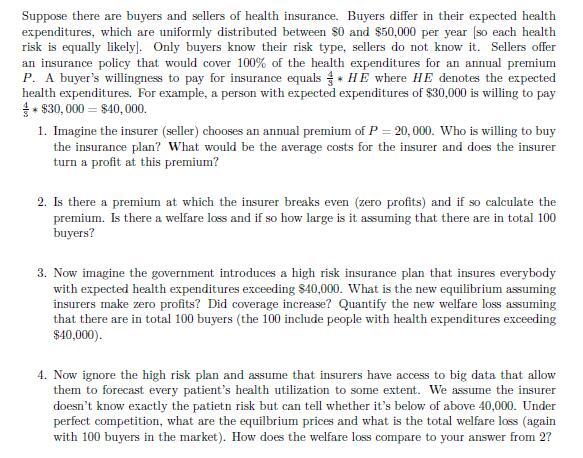Suppose there are buyers and sellers of health insurance. Buyers differ in their expected health expenditures, which are uniformly distributed between $0 and $50,000 per year [so each health risk is equally likely]. Only buyers know their risk type, sellers do not know it. Sellers offer an insurance policy that would cover 100% of the health expenditures for an annual premium P. A buyer' s willingness to pay for insurance equals 4/3 * HE where HE denotes the expected health expenditures. For example, a person with expected expenditures of $30,000 is willing to pay 4/3 * $30, 000 = $40, 000.

Suppose there are buyers and sellers of health insurance. Buyers differ in their expected health expenditures, which are uniformly distributed between 0 and $50,000 per year (so each health risk is equally likely]. Only buyers know their risk type, sellers do not know it. Sellers offer an insurance policy that would cover 100% of the health expenditures for an annual premium P. A buyer's willingness to pay for insurance equals & HE where HE denotes the expected health expenditures. For example, a person with expected expenditures of $30,000 is willing to pay $* $30,000 = $40,000. 1. Imagine the insurer (seller) chooses an annual premium of P = 20,000. Who is willing to buy the insurance plan? What would be the average costs for the insurer and does the insurer turn a profit at this premium? 2. Is there a premium at which the insurer breaks even (zero profits) and if so calculate the premium. Is there a welfare loss and if so how large is it assuming that there are in total 100 buyers? 3. Now imagine the government introduces a high risk insurance plan that insures everybody with expected health expenditures exceeding $40,000. What is the new equilibrium assuming insurers make zero profits? Did coverage increase? Quantify the new welfare loss assuming that there are in total 100 buyers (the 100 include people with health expenditures exceeding $40,000) 4. Now ignore the high risk plan and assume that insurers have access to big data that allow them to forecast every patient's health utilization to some extent. We assume the insurer doesn't know exactly the patietn risk but can tell whether it's below of above 40,000. Under perfect competition, what are the equilbrium prices and what is the total welfare loss (again with 100 buyers in the market). How does the welfare loss compare to your answer from 2? Suppose there are buyers and sellers of health insurance. Buyers differ in their expected health expenditures, which are uniformly distributed between 0 and $50,000 per year (so each health risk is equally likely]. Only buyers know their risk type, sellers do not know it. Sellers offer an insurance policy that would cover 100% of the health expenditures for an annual premium P. A buyer's willingness to pay for insurance equals & HE where HE denotes the expected health expenditures. For example, a person with expected expenditures of $30,000 is willing to pay $* $30,000 = $40,000. 1. Imagine the insurer (seller) chooses an annual premium of P = 20,000. Who is willing to buy the insurance plan? What would be the average costs for the insurer and does the insurer turn a profit at this premium? 2. Is there a premium at which the insurer breaks even (zero profits) and if so calculate the premium. Is there a welfare loss and if so how large is it assuming that there are in total 100 buyers? 3. Now imagine the government introduces a high risk insurance plan that insures everybody with expected health expenditures exceeding $40,000. What is the new equilibrium assuming insurers make zero profits? Did coverage increase? Quantify the new welfare loss assuming that there are in total 100 buyers (the 100 include people with health expenditures exceeding $40,000) 4. Now ignore the high risk plan and assume that insurers have access to big data that allow them to forecast every patient's health utilization to some extent. We assume the insurer doesn't know exactly the patietn risk but can tell whether it's below of above 40,000. Under perfect competition, what are the equilbrium prices and what is the total welfare loss (again with 100 buyers in the market). How does the welfare loss compare to your answer from 2







